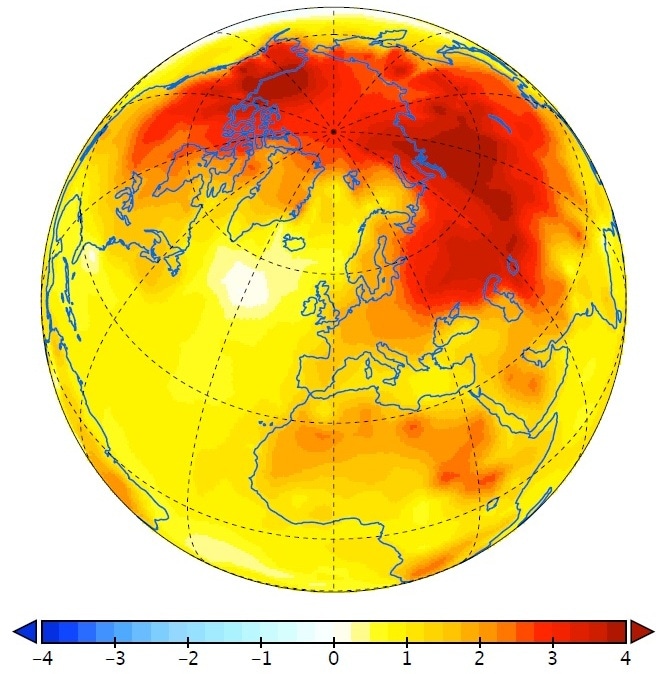Nov 20 2018
An increased surface warming in Alaska, Siberia, Canada, and in the Arctic Ocean in relation to global mean temperature rise has been revealed by long-term observations of surface temperatures.
 Amplification factor of observed surface temperatures relative to the global mean surface temperature (from 1951-2017). The observations show a clear enhancement of warming in the Arctic region and across Siberia, Northern Canada, and Alaska. (Image credit: Institute for Basic Science)
Amplification factor of observed surface temperatures relative to the global mean surface temperature (from 1951-2017). The observations show a clear enhancement of warming in the Arctic region and across Siberia, Northern Canada, and Alaska. (Image credit: Institute for Basic Science)
Often known as Arctic amplification, this warming pattern has been shown to be consistent with computer models, replicating the response to the growing concentrations of greenhouse gases. Yet, the fundamental physical processes for the intensified surface continue to be elusive.
Now, a new international research analysis focused on the cause of Arctic amplification reported in the journal Nature Climate Change demonstrates that Arctic climate feedbacks as well as local concentrations of greenhouse gas outweigh other processes. With the help of complex computer simulations, the researchers successfully refuted the formerly proposed theory, which highlighted the role of heat transport from the tropics to the poles as one of the main contributors to the increased warming in the Arctic region.
Our study clearly shows that local carbon dioxide forcing and polar feedbacks are most effective in Arctic amplification compared to other processes.
Malte Stuecker, Project Leader and Study Corresponding Author, IBS Center for Climate Physics
Growing concentrations of anthropogenic carbon dioxide (CO2) trap atmospheric heat, leading to surface warming. This effect can be further amplified or dampened by regional processes, thus producing the regular pattern of global warming. Surface warming decreases the extent of snow and sea-ice in the Arctic region, and subsequently decreases surface reflectivity. Consequently, more amounts of sunlight can reach the top of the soil and ocean layers, resulting in accelerated warming. In addition, warming in the polar regions can be further enhanced by variations in Arctic clouds as well as in the vertical atmospheric temperature profile.
Aside from these factors, winds can transport heat into the Arctic region.
We see this process for instance during El Niño events. Tropical warming, caused either by El Niño or anthropogenic greenhouse emissions, can cause global shifts in atmospheric weather patterns, which may lead to changes in surface temperatures in remote regions, such as the Arctic.
Kyle Armour, Professor of Atmospheric Sciences and Oceanography and Study Co-Author, University of Washington
In addition, global warming beyond the Arctic region will also raise the temperatures of the Atlantic Ocean. Ocean currents, for example, the North Atlantic drift and the Gulf Stream can subsequently transport the warmer waters to the Arctic Ocean, where they may melt the sea ice and undergo more amplification owing to local processes.
The researchers then went on to develop an array of computer model simulations to establish whether tropical warming, ocean current changes, and atmospheric wind play a role in future Arctic amplification.
By comparing simulations with only Arctic CO2 changes with simulations that apply CO2 globally, we find similar Arctic warming patterns. These findings demonstrate that remote physical processes from outside the polar regions do not play a major role, in contrast to previous suggestions.
Cecilia Bitz, Professor of Atmospheric Sciences and Study Co-Author, University of Washington
In the tropics—driven by high moisture and temperature—air can freely move up to high altitudes, which indicates an unstable atmosphere. On the other hand, the atmosphere in the Arctic region is relatively more stable with regards to the vertical movement of air. This condition improves the CO2-induced warming in the Arctic region close to the surface. In the tropics—owing to the inconsistent atmosphere—the upper atmosphere is mostly warmed by CO2, causing loss of energy to space. This is reverse to what occurs in the Arctic region—less outgoing infrared radiation breaks off from the atmosphere, which additionally increases the surface-trapped warming.
Our computer simulations show that these changes in the vertical atmospheric temperature profile in the Arctic region outweigh other regional feedback factors, such as the often-cited ice-albedo feedback.
Malte Stuecker, Project Leader and Study Corresponding Author, IBS Center for Climate Physics
The latest discoveries of this work emphasize the significance of Arctic processes in regulating the rate at which sea-ice will retreat in the Arctic Ocean. The outcomes are also equally significant to infer how the Greenland ice-sheet, Arctic permafrost, and sensitive polar ecosystems will react to global warming.